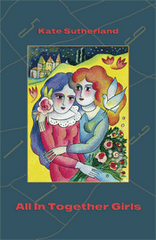These characters don’t undergo any grand traumas in the course of the book, just the subtle-on-the-outside, major-on-the-inside sort of shifts that are apt to occur in an adolescent summer. Kids who have been friends all their lives find themselves drifting in different directions as they develop new interests and identities. The boys and the girls suddenly recognize one other as boys and girls, not so much in a sexual attraction sense as in a socially awkward sense. Everything begins to change.
The “Criss Cross” of the title is the name of a radio show that Debbie, Hector, Lenny, and friends gather to listen to every week:
Hanging out in the truck listening to the radio show got to be a regular thing. It wasn’t an official plan, but almost every Saturday night through the spring, and then the summer, they all showed up and sat there in the parked truck in Lenny’s driveway with the radio on.
The phrase “criss cross” also gestures at a broader theme of the book, the interwoven lives of these teenagers as they move away from one other and back again. It hints at missed communication among and between them, their parents, and other people that matter in their lives. Here’s a passage in which Debbie wishes but fails to confide in her mother:
Her mother had no way of knowing that this would have been a good time to tell her daughter that she had once known a boy who went away… They might have talked then about how that felt, and what you did next. But their secrets inadvertently sidestepped each other, unaware, like blindfolded elephants crossing the tiny room.
Finally, the phrase “criss cross" connects with the novel’s innovative structure. The book is comprised of short sections that shift between the perspectives of the various characters. Some of these sections are conventionally written, while others are in the form of dialogues, song lyrics, and split-screen columns simultaneously offering two points of view on the same events. The text is peppered with illustrations scrapbook-style: drawings, photos, diagrams, and comic strips.
The structure of the novel combined with the lyrical language used throughout give it a whimsical quality, but ultimately the characters are so fully drawn, so fallible and real, that it retains a sense of solidity as well. I loved this book. It seems to me to be fully deserving of the 2006 Newbery Medal that it was awarded as this year's most distinguished contribution to American literature for children.
The flyleaf indicates that Criss Cross is aimed at children ages ten and up. There’s an innocence about it that certainly makes it appropriate for readers younger than the fourteen-year-old protagonists. But there’s also a subtlety to the writing that I suspect might be better appreciated by children older than ten. I’ll try it out on my soon to be twelve-year-old niece and see if she likes it as well as I do.

3 comments:
I'm on the list at the library for this! I think it's going to be a singularly wonderful read for two reasons:
1) I'm in my adolescence yet again;
2) My brain is following an unusual narrative structure.
Nice review, Kate! I really get a sense of the book from your review. I just read it, 'cause I couldn't access your site yesterday.
Love That Book!!!
Post a Comment